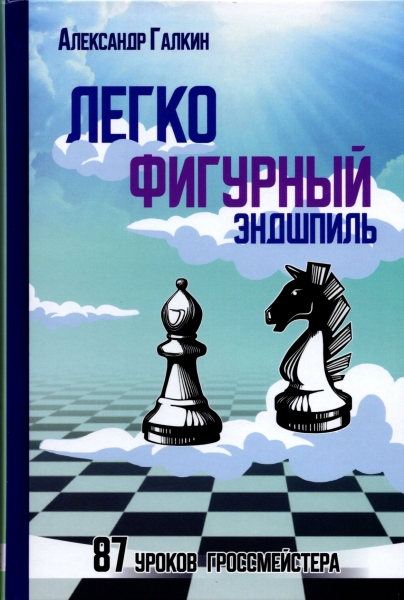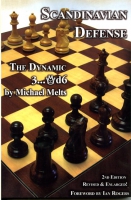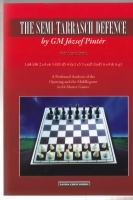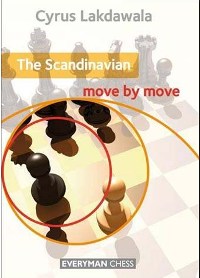Books 1991-2023
-
-
48.37 $
Professional grandmasters study the latest wrinkles of their favorite openings. They have time to think about innovations in the Sicilian Najdorf, the Marshall Attack, or the Semi-Slav. It’s part of their job. But club players can rarely afford such luxury, and an excellent way for them to beat their busy schedules is to play good, solid opening lines that happen to be out of style. GM Raetsky and IM Chetverik have turned their backs on current fashion and have delved deep into the wardrobe of chess openings. These two opening specialists have selected eleven unusual variations to help readers refresh their repertoires. Using key illustrative games (many previously unpublished), the authors present a host of surprising and accessible opening ideas. Never refuted, these openings have numbered World Champions among their victims.
-
Now, in the second edition of The Scandinavian Defense: The Dynamic 3 ... Qd6, the author has added a tremendous amount of new analysis, insight and practical recommendations. This revised and enlarged second edition will provide both a solid foundation for meeting 1.e4 while at the same time allowing considerable room for creativity and original play. "Melts' serious study of a serious opening shows that at the moment not much need scare Black. Easy to play and theoretically sound - how many openings can boast that?" - From the Foreword by Australian Grandmaster Ian Rogers "I highly recommend Scandinavian Defense: The Dynamic 3 ... Qd6 for any club player who has struggled to find a line against 1. e4 they feel comfortable with. The material in this book provides more than enough ammunition to allow the average player security again just about anything White throws at them. Given the amount of effort that Michael Melts has put into this text, I have no doubt there will be plenty of stronger players who will want a copy too. " -Edward Scimia, About.com
-
34.55 $
A life-long Sozin devotee explains the subtleties of this aggressive system for White. The Sozin Attack is White’s most overtly aggressive counter to the Sicilian. White puts his bishop on c4, and often follows up with direct play against the black king. Unless Black defends with the utmost precision, the bishop’s influence often fuels a deadly attack leading to a cascade of sacrifices and a brutal king-hunt. The Sozin set-up can be employed against the Classical Sicilian, the Najdorf and even the Scheveningen. This book presents in detail the theory of the Sozin in all its forms, including the razor-sharp Velimirovic Attack.
-
31.09 $
Contains the variations 1.d4 Nf6 2.c4 e6 3.Nf3 d5 4.Nc3 c5 5.cxd5 Nxd5 6.e4 & 6.g3 and deals with the subject of 'isolated pawn', which plays an important part in this opening, quoting Dr Siegbert Tarrasch words: "Whoever is afraid of playing with an isolated pawn should give up chess."
-
The present, second volume (Games 35-64) contains all the variations beginning with 1.d4 Nf6 2.c4 e6 3.Nf3 d5 4.Nc3 c5 5.cxd5 Nxd5 6.e3. It also includes an Index of Variations for both Volumes.
-
Dear reader, you are holding the first part of a two-volume work in your hands. I'd like to lead you to a world mysterious and unknown even to trained chess players, in fact, more or less to grandmasters. I trust that reading this book will give you not only joy and entertainment but it will also help you to understand these extremely interesting and exiting endgames. Furthermore, I hope that as as result, later on you will be able to successfully adopt in practice all that you learn from this book. The topics are the following: The three positions of the introductory part shed light on what urged me to deal in such minuteness of detail with opposite-colored bishop endings. In the basic positions I arranged in a row the most important types of positions of connected and split pawns, the self-confident knowledge of which is essential to be able to solve the more complicated, multi pawn positions. In the examples of practical endings you can see all the virtues and errors which spring from the knowledge, or the lack of it, of the rules of opposite-colored bishop endings. The epilogue supports all that was written, and briefly summarizes the rules. I should like to express my special thanks to my ex-pupil GM Ferenc Berkes for his many and profound analysing work, and for always finding time to discuss any newly arisen, interesting-looking positions with me.
-
GM Delchev once again delved deeply in his pet defense and came up with several improvements and new ideas. You can expect added material and major revisions in the following variations: • English Attack vs the Taimanov • Classical System with 6.Be2 • System with Ld3 and Le3 • Alapin Variation 3.c3 The Bulgarian GM Delchev (current Elo 2661) proposes a sound yet aggressive Black Sicilian repertoire, based on the Taimanov system: 1.e4 c5 2.Nf3 e6 3.d4 cd4 4.Nd4 Nc6 5.Nc3 Qc7. As Black, it is extremely difficult to get a playable position without accepting extreme risks. This book deals with reliable positional systems which will serve you for many years, without having to update your opening knowledge every two weeks. This setup is especially effective against the dreaded English attack. The author is one of the world’s leading experts in that field and his recommendations are based mostly on his own games. Without hiding back his secrets, Delchev reveals many new ideas and novelties in his pet line. The authors pay also attention to White’s deviations from the Open Sicilian. There are chapters about 3.c3, 3.d3, 3.Nc3, 3.b3, 3.c4 and other rare lines. The book features a new form of presentation. Every system is examined in a separate part which contains three chapters: “Quick Repertoire”; “Step by Step”; “Complete Games”. You start with the “Quick Repertoire”. You’ll find there all the vital information that you need to start playing the variation. “Step by Step” chapters follow the usual layout of Chess Stars books with main lines that branch to sub-lines. Finally, every part ends with “Complete Games”.
-
Dangerous Weapons is a series of opening books which supply the reader with an abundance of hard-hitting ideas to revitalize his or her opening repertoire. In this book, three opening experts team up and take a contemporary look at the Ruy Lopez, one of the most popular chess openings. Instead of analysing the well-trodden main lines they concentrate on fresh or little-explored variations, selecting a wealth of ‘dangerous’ options for both colors. Whether playing White or Black, a study of this book will leave you confident and fully-armed, and your opponents running for cover!
-
American IM Cyrus Lakdawala loves the Scandinavian, and it shows. He focuses on popular lines with 3 ... Qd6 and presents a reliable repertoire in which White has problems to open the position, lacks specific targets and quite often cannot resist Black's tempting invitation to overreach.
-
 Mikhail Tal. All parties. Volume 2. 1963 - 1972
Author:
Mikhail Tal. All parties. Volume 2. 1963 - 1972
Author:
Khalifman 60.00 $ -
 Mikhail Tal. All parties. Volume 1. 1949 - 1962
Author:
Mikhail Tal. All parties. Volume 1. 1949 - 1962
Author:
Khalifman 60.00 $ -
 Chess. Fundamentals of the theory. (Artistic Exclusive Leather Binding) Art - (eb)
Author:
Chess. Fundamentals of the theory. (Artistic Exclusive Leather Binding) Art - (eb)
Author:
Maiselis 250.00 $ -
 Japanese chess shogi
Author:
Japanese chess shogi
Author:
Nosovsky 75.00 $ -
 Chess composition in Azerbaijan / Азəрбаjҹанда шаhмат композисиjасы
Author:
Chess composition in Azerbaijan / Азəрбаjҹанда шаhмат композисиjасы
Author:
Sarichev 62.50 $ -
 Check it out for you, reader
Author:
Check it out for you, reader
Author:
Yatskevich 15.00 $ -
 Notebook of the chess player of the Russian Chess Federation
4.25 $
Notebook of the chess player of the Russian Chess Federation
4.25 $
-
 Lessons of Mastery. Second edition, revised
Author:
Lessons of Mastery. Second edition, revised
Author:
Dvoretsky 18.75 $ -
 Alexandra Goryachkina: On the way to the chess Olympus
Author:
Alexandra Goryachkina: On the way to the chess Olympus
Author:
Kryakvin 18.75 $ -
 Complete Encyclopedia of Health by Dr. Zalmanov
Author:
Complete Encyclopedia of Health by Dr. Zalmanov
Author:
Zalmanov 16.00 $
 Русский
Русский  Английский
Английский 




















